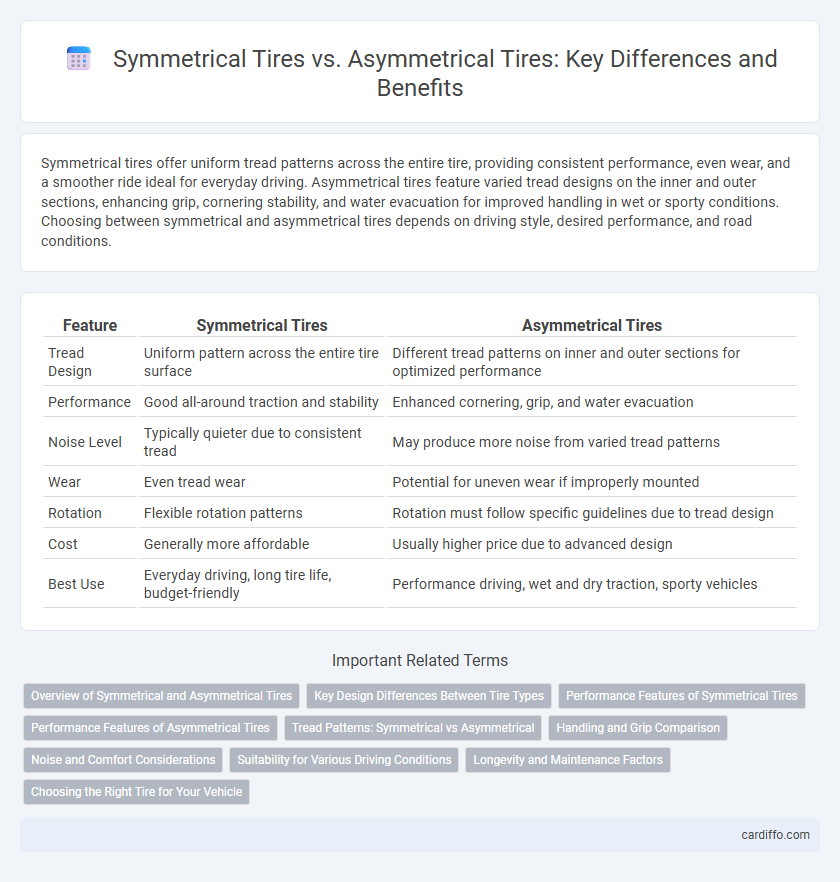Symmetrical tires offer uniform tread patterns across the entire tire, providing consistent performance, even wear, and a smoother ride ideal for everyday driving. Asymmetrical tires feature varied tread designs on the inner and outer sections, enhancing grip, cornering stability, and water evacuation for improved handling in wet or sporty conditions. Choosing between symmetrical and asymmetrical tires depends on driving style, desired performance, and road conditions.
Table of Comparison
| Feature | Symmetrical Tires | Asymmetrical Tires |
|---|---|---|
| Tread Design | Uniform pattern across the entire tire surface | Different tread patterns on inner and outer sections for optimized performance |
| Performance | Good all-around traction and stability | Enhanced cornering, grip, and water evacuation |
| Noise Level | Typically quieter due to consistent tread | May produce more noise from varied tread patterns |
| Wear | Even tread wear | Potential for uneven wear if improperly mounted |
| Rotation | Flexible rotation patterns | Rotation must follow specific guidelines due to tread design |
| Cost | Generally more affordable | Usually higher price due to advanced design |
| Best Use | Everyday driving, long tire life, budget-friendly | Performance driving, wet and dry traction, sporty vehicles |
Overview of Symmetrical and Asymmetrical Tires
Symmetrical tires feature a uniform tread pattern across the entire tire, promoting even wear and providing a smooth, quiet ride ideal for everyday driving. Asymmetrical tires combine different tread patterns on the inner and outer sections, optimizing handling, traction, and cornering performance for sportier driving conditions. Choosing between symmetrical and asymmetrical tires depends on specific driving needs, vehicle type, and performance priorities.
Key Design Differences Between Tire Types
Symmetrical tires feature a uniform tread pattern across the entire surface, providing consistent performance and easier rotation options, while asymmetrical tires combine different tread patterns on the inner and outer sections to optimize grip, handling, and water evacuation. The symmetrical design excels in durability and noise reduction, whereas the asymmetrical design enhances cornering stability and wet traction by placing larger tread blocks on the outside and smaller grooves inside. Key design differences impact tire rotation flexibility, directional performance, and overall vehicle responsiveness.
Performance Features of Symmetrical Tires
Symmetrical tires offer uniform tread patterns on both sides, ensuring even wear and consistent performance across various driving conditions. Their design promotes lower rolling resistance, contributing to improved fuel efficiency and a quieter, smoother ride. These tires excel in durability and stability, making them ideal for everyday driving and standard road surfaces.
Performance Features of Asymmetrical Tires
Asymmetrical tires enhance performance by combining multiple tread patterns optimized for varied driving conditions, improving grip and handling on both wet and dry surfaces. Their design features distinct inner and outer tread zones, with the outer area providing cornering stability and the inner zone designed for water dispersion to reduce hydroplaning risk. This optimized tread arrangement delivers superior traction, precise steering response, and balanced wear compared to symmetrical tires.
Tread Patterns: Symmetrical vs Asymmetrical
Symmetrical tires feature a uniform tread pattern across the entire tire, providing consistent performance, longer tread life, and quiet operation ideal for everyday driving. Asymmetrical tires combine different tread patterns on the inner and outer edges, enhancing cornering grip and water evacuation for improved handling and traction in varied driving conditions. Choosing between symmetrical and asymmetrical tread patterns depends on balancing fuel efficiency and comfort with performance and wet-weather capability.
Handling and Grip Comparison
Symmetrical tires offer uniform tread patterns on both sides, providing consistent handling and even wear, making them ideal for everyday driving with predictable grip on dry and wet surfaces. Asymmetrical tires feature varied tread designs on the inner and outer sections, optimizing cornering performance and maximizing grip by enhancing traction in dry conditions and water evacuation for improved wet handling. The choice between symmetrical and asymmetrical tires significantly impacts vehicle stability and responsiveness, with asymmetrical designs often preferred for high-performance driving due to superior lateral grip and precise steering control.
Noise and Comfort Considerations
Symmetrical tires typically offer a quieter ride due to their uniform tread pattern, which reduces road noise and enhances comfort on smooth surfaces. Asymmetrical tires, designed for performance with varied tread blocks, may produce slightly more noise but provide better handling and grip. Choosing between them depends on prioritizing a smooth, quiet driving experience or improved traction and cornering stability.
Suitability for Various Driving Conditions
Symmetrical tires provide consistent performance and uniform tread wear, making them ideal for everyday driving on smooth, paved roads and moderate weather conditions. Asymmetrical tires offer enhanced traction and cornering stability due to their distinct inner and outer tread patterns, suited for high-performance vehicles and variable road surfaces including wet and dry conditions. Choosing between these tire types depends on driving style, vehicle requirements, and the predominant road conditions encountered.
Longevity and Maintenance Factors
Symmetrical tires typically offer longer tread life due to even wear patterns and simpler rotation options that help maintain balanced tire condition. Asymmetrical tires, while providing enhanced grip and performance, often require more frequent and specific maintenance, including targeted rotation patterns to prevent uneven wear and preserve tire longevity. Choosing symmetrical tires can reduce maintenance complexity and extend overall tire lifespan, especially for drivers prioritizing durability.
Choosing the Right Tire for Your Vehicle
Symmetrical tires offer consistent tread patterns across the entire tire, providing excellent stability, even wear, and a quieter ride, making them ideal for everyday driving and budget-conscious vehicle owners. Asymmetrical tires feature varied tread patterns designed to optimize traction, handling, and cornering performance, which benefits sporty cars and high-performance vehicles seeking enhanced grip in diverse driving conditions. Selecting the right tire depends on vehicle type, driving style, and road conditions, with symmetrical tires suited for durability and comfort, while asymmetrical tires prioritize performance and safety at higher speeds.
Symmetrical tires vs asymmetrical tires Infographic

 cardiffo.com
cardiffo.com